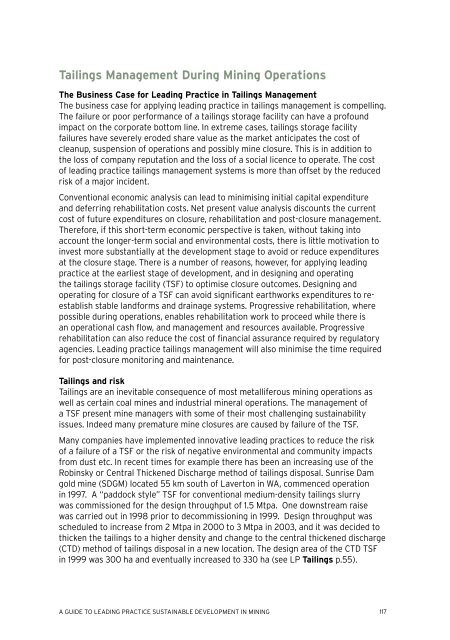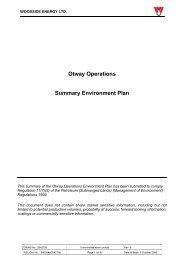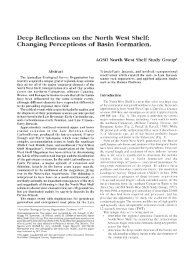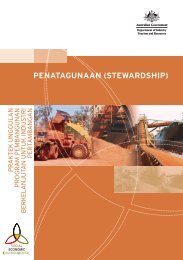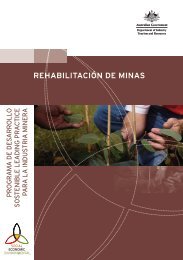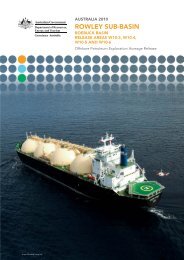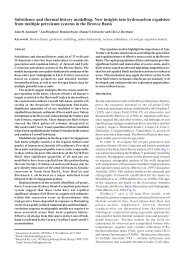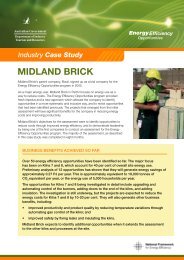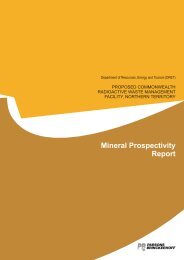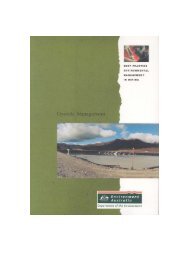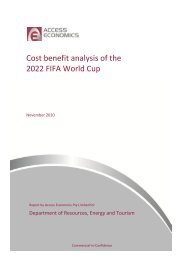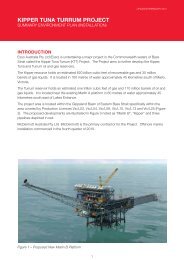A guide to leading practice sustainable development in mining
A guide to leading practice sustainable development in mining
A guide to leading practice sustainable development in mining
You also want an ePaper? Increase the reach of your titles
YUMPU automatically turns print PDFs into web optimized ePapers that Google loves.
Tail<strong>in</strong>gs Management Dur<strong>in</strong>g M<strong>in</strong><strong>in</strong>g Operations<br />
The Bus<strong>in</strong>ess Case for Lead<strong>in</strong>g Practice <strong>in</strong> Tail<strong>in</strong>gs Management<br />
The bus<strong>in</strong>ess case for apply<strong>in</strong>g <strong>lead<strong>in</strong>g</strong> <strong>practice</strong> <strong>in</strong> tail<strong>in</strong>gs management is compell<strong>in</strong>g.<br />
The failure or poor performance of a tail<strong>in</strong>gs s<strong>to</strong>rage facility can have a profound<br />
impact on the corporate bot<strong>to</strong>m l<strong>in</strong>e. In extreme cases, tail<strong>in</strong>gs s<strong>to</strong>rage facility<br />
failures have severely eroded share value as the market anticipates the cost of<br />
cleanup, suspension of operations and possibly m<strong>in</strong>e closure. This is <strong>in</strong> addition <strong>to</strong><br />
the loss of company reputation and the loss of a social licence <strong>to</strong> operate. The cost<br />
of <strong>lead<strong>in</strong>g</strong> <strong>practice</strong> tail<strong>in</strong>gs management systems is more than offset by the reduced<br />
risk of a major <strong>in</strong>cident.<br />
Conventional economic analysis can lead <strong>to</strong> m<strong>in</strong>imis<strong>in</strong>g <strong>in</strong>itial capital expenditure<br />
and deferr<strong>in</strong>g rehabilitation costs. Net present value analysis discounts the current<br />
cost of future expenditures on closure, rehabilitation and post-closure management.<br />
Therefore, if this short-term economic perspective is taken, without tak<strong>in</strong>g <strong>in</strong><strong>to</strong><br />
account the longer-term social and environmental costs, there is little motivation <strong>to</strong><br />
<strong>in</strong>vest more substantially at the <strong>development</strong> stage <strong>to</strong> avoid or reduce expenditures<br />
at the closure stage. There is a number of reasons, however, for apply<strong>in</strong>g <strong>lead<strong>in</strong>g</strong><br />
<strong>practice</strong> at the earliest stage of <strong>development</strong>, and <strong>in</strong> design<strong>in</strong>g and operat<strong>in</strong>g<br />
the tail<strong>in</strong>gs s<strong>to</strong>rage facility (TSF) <strong>to</strong> optimise closure outcomes. Design<strong>in</strong>g and<br />
operat<strong>in</strong>g for closure of a TSF can avoid significant earthworks expenditures <strong>to</strong> reestablish<br />
stable landforms and dra<strong>in</strong>age systems. Progressive rehabilitation, where<br />
possible dur<strong>in</strong>g operations, enables rehabilitation work <strong>to</strong> proceed while there is<br />
an operational cash flow, and management and resources available. Progressive<br />
rehabilitation can also reduce the cost of f<strong>in</strong>ancial assurance required by regula<strong>to</strong>ry<br />
agencies. Lead<strong>in</strong>g <strong>practice</strong> tail<strong>in</strong>gs management will also m<strong>in</strong>imise the time required<br />
for post-closure moni<strong>to</strong>r<strong>in</strong>g and ma<strong>in</strong>tenance.<br />
Tail<strong>in</strong>gs and risk<br />
Tail<strong>in</strong>gs are an <strong>in</strong>evitable consequence of most metalliferous m<strong>in</strong><strong>in</strong>g operations as<br />
well as certa<strong>in</strong> coal m<strong>in</strong>es and <strong>in</strong>dustrial m<strong>in</strong>eral operations. The management of<br />
a TSF present m<strong>in</strong>e managers with some of their most challeng<strong>in</strong>g susta<strong>in</strong>ability<br />
issues. Indeed many premature m<strong>in</strong>e closures are caused by failure of the TSF.<br />
Many companies have implemented <strong>in</strong>novative <strong>lead<strong>in</strong>g</strong> <strong>practice</strong>s <strong>to</strong> reduce the risk<br />
of a failure of a TSF or the risk of negative environmental and community impacts<br />
from dust etc. In recent times for example there has been an <strong>in</strong>creas<strong>in</strong>g use of the<br />
Rob<strong>in</strong>sky or Central Thickened Discharge method of tail<strong>in</strong>gs disposal. Sunrise Dam<br />
gold m<strong>in</strong>e (SDGM) located 55 km south of Laver<strong>to</strong>n <strong>in</strong> WA, commenced operation<br />
<strong>in</strong> 1997. A “paddock style” TSF for conventional medium-density tail<strong>in</strong>gs slurry<br />
was commissioned for the design throughput of 1.5 Mtpa. One downstream raise<br />
was carried out <strong>in</strong> 1998 prior <strong>to</strong> decommission<strong>in</strong>g <strong>in</strong> 1999. Design throughput was<br />
scheduled <strong>to</strong> <strong>in</strong>crease from 2 Mtpa <strong>in</strong> 2000 <strong>to</strong> 3 Mtpa <strong>in</strong> 2003, and it was decided <strong>to</strong><br />
thicken the tail<strong>in</strong>gs <strong>to</strong> a higher density and change <strong>to</strong> the central thickened discharge<br />
(CTD) method of tail<strong>in</strong>gs disposal <strong>in</strong> a new location. The design area of the CTD TSF<br />
<strong>in</strong> 1999 was 300 ha and eventually <strong>in</strong>creased <strong>to</strong> 330 ha (see LP Tail<strong>in</strong>gs p.55).<br />
A GUIDE TO LEADING PRACTICE SUSTAINABLE DEVELOPMENT IN MINING 117


